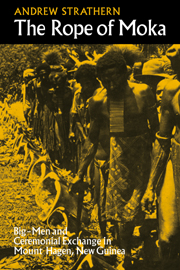Book contents
- Frontmatter
- Contents
- List of tables
- List of illustrations
- Preface
- Preface to the New Edition
- Abbreviations and orthography
- Dedication
- 1 Introduction
- 2 Groups
- 3 Ceremonial grounds
- 4 Warfare, alliance, and compensation
- 5 Moka transactions and media of exchange
- 6 Moka chains
- 7 Counting pigs and shells
- 8 Disputes and struggles precipitated by moka occasions
- 9 Moka and the status of big-man
- 10 The moka system and the behaviour of big-men
- Appendices
- Bibliography
- Index
- Cambridge Studies in Social Anthropology
- Frontmatter
- Contents
- List of tables
- List of illustrations
- Preface
- Preface to the New Edition
- Abbreviations and orthography
- Dedication
- 1 Introduction
- 2 Groups
- 3 Ceremonial grounds
- 4 Warfare, alliance, and compensation
- 5 Moka transactions and media of exchange
- 6 Moka chains
- 7 Counting pigs and shells
- 8 Disputes and struggles precipitated by moka occasions
- 9 Moka and the status of big-man
- 10 The moka system and the behaviour of big-men
- Appendices
- Bibliography
- Index
- Cambridge Studies in Social Anthropology
Summary
But, tell me, what are your origins, where are you from? You did not spring from the fabled oak, or from a rock.
Homer, Odyssey 19. 163At Hagen the fieldworker rapidly becomes aware of the high-level, named groups in his area, for a person's group-membership is regularly indicated in conversation by prefixing it to his (or her) personal name.
The most regularly mentioned high-level groups are those which I call tribes. These are the groups one is likely to hear mentioned most often: the Ndika, Mokei, Kumndi, Nengka, and so on near to Mount Hagen township, the Tipuka, Kombukla, Minembi, Kawelka and others in the area north of the township where most of my work was done.
Despite the frequency with which one meets such tribal names, defining a tribe in general terms is no simple matter. One reason for this is that these major groups vary greatly in size and segmentation pattern, and correspondingly in the functions carried out by segments at various levels. In this chapter I shall discuss this problem of variation in the size of tribes first; second I shall attempt to establish a set of working definitions for different group-levels; and finally I shall describe the idioms in terms of which Hageners themselves refer to their groups and how these relate to actual processes of individual affiliation to groups.
VARIATION IN GROUP SIZE
The largest tribes are those living on the Ogelbeng Plain, or just south of it, and on the slopes of Mount Hagen.
- Type
- Chapter
- Information
- The Rope of MokaBig-men and Ceremonial Exchange in Mount Hagen New Guinea, pp. 15 - 36Publisher: Cambridge University PressPrint publication year: 1971



